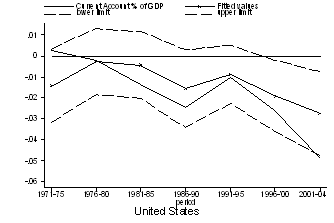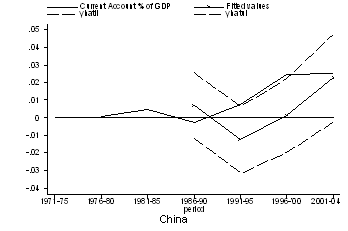Is there statistical evidence for the “global savings glut”?
by Guest Blogger: Menzie Chinn
Fed Chair nominee Ben Bernanke’s “global savings glut” speech
has gained renewed prominence here, here,
and here . In current work, Hiro Ito and I have been examining this question. Using a large panel of 117 countries over the past 30 years, we
find that (1) the impact of budget deficits on current account deficits is about 0.20 (with an impact as high as 0.40 if statistical uncertainty is taken into account), and (2) the U.S. current account deficits behavior over the 2001-03 period is only
barely anomalous, by statistical criteria. [A footnote: budget deficits are always statistically significant in all the specifications] The analysis focuses on the medium term determinants of current account deficits (taking
exchange rates as endogenous). The right hand side variables in the regressions, in addition to budget deficits, are demographic variables, financial and
trade openness, and financial development. The figure below shows the actual, predicted and 2 standard error bounds.

To the extent that there is mis-prediction, a lot of it seems to be correlated with equity market developments.
Interestingly, China’s behavior in this latest 2001-03 period was not out of the range of ordinary behavior, as shown in
the figure below:

This is not to deny that there may be a global savings glut. Maybe excess savings in East Asia — due to either savings glut or investment drought —
are important in causing the U.S. current deficit. But these empirical results do show it’s dangerous to argue on the basis of identities (as
Brad DeLong has argued).
It’s also a cautionary note for those would assert that the world is obeying radically new rules.
The statistical evidence on that count is weak.
“It is ludicrous, therefore, when American economists claim that rising asset prices, increasing consumption, should by counted as saving… The world economy seems to be flooded with liquidity. But there are two diametrically different kinds of liquidity: earned liquidity and borrowed liquidity. The former comes from surplus income or savings; the latter comes from credit and debt creation.”
http://www.gold-eagle.com/gold_digest_05/richebacher091705.html
Well done, Menzie. I think that with regard to China people need to keep in mind that its overall current account surpluses are not as large as many in the US would think, given the particularly large US-Chinese imbalance. China runs deficits with many other countries that send it raw materials and parts.
Barkley
China has, since 03, run up a pretty huge current account surplus – about 8% of GDP in the first half of this year.
This is, granted, smaller than their bilateral US surplus, but, not much.
what joshb said. China’s current account surplus started to soar in late 04, and really ballooned in the first half of this year.
Menzie — need to read your paper, obviously, but three questions:
a) if i am reading the graph correctly, it ends with 01-4, i.e. fourth quarter 01. is that right? or are their a couple of post 01 observations squeezed in that I am missing?
b) have you tried to fit the latest observations from china (8% of GDP CAS), particularly the q1 and q2 05 data (q3 04 won’t be different unless transfers fall big time) into the model?
c)would housing act like equities for the us in 04/05?
JoshB and Brad Setser make important observations. One limitation of the analysis Ito and I conducted is that a complete data for the panel analyses is only available up to 2003 (the graphs have a typo: they last observation is 01-03 for 2001-03). Hence, we cannot really tackle the issue of the current account imbalances of 2004-05 are due to the savings glut or not.
I think one way of looking at these results is that assertions that the entire period since the East Asian crises has been characterized by abnormal behavior of the current account are not supported by the data.
What would be interesting to find out is whether the 2004-05 US current account is driven by foreign influence, perhaps due to depressed long term interest rates and consequently elevated household wealth. We don’t have cross-country time-series data on household wealth, so we weren’t able to evaluate this hypothesis. If somebody has done this, I’d certainly be interested in hearing about it.
Menzie,
I reviewed your paper.
I’ll be pleased when you are willing to devote comparable effort to studying the production investment flows. That’s missing subject matter from many economic discussions and presentations.
Leaving aside ‘inadequate consumer demand’ on a global basis as a magic justification for Ben’s original assertion that there is a global savings glut, a proper indepth study of ongoing business decisions with regard to production investment levels will provide many answers to a range of questions.
Once this business model is understood (and I note little if any evidence that many economists really understand it or have attempted to communicate with corporate leaders to get a handle on the scope of production decisions), the effects of production source shifting become more apparent in terms of domestic GDP growth impact.
Under the WTO and U.S. trade policy regime, there should be every expectation that reductions in overall investment needs will be accomplished under investment convergence. And, as importantly, the level of necessary plus up of future investment in the same production of goods trails off when there is no pressing demand to further improve efficiencies in the short term as necessary to remain competitive or maximize profits beyond present levels.
The results of advanced trade movements are coming into play. The business leaders understand what is happening. Many others understand the general framework. But, for reasons that make little sense to me, a majority of economists do not understand the principle of investment convergence nor the lag created in supplementing previous investment flows depending on the production model mix involved.
Similarly, the lack of acknowledgement in the decline or disappearance of the proportional level of GDP performance from the supporting industries and suppliers chains which provided feeder support to production operations that used to be located in the U.S. or elsewhere in the developed industrialized world community is another oversight. Again, I don’t care what type of model one is trying to use to sort out these factors. That doesn’t matter to me. All one has to do is communicate with some of the 450 of 500 largest U.S. corporations that have established operations in China and elsewhere in the last few years to grasp the realities that the production sourcing changes resulted in net investment and net production savings.
Equity modeling and analysis is on the other end of production investment analysis. Yet, we are seeing little effort put forth to understand the implications of WTO and U.S. trade policy initiatives. Why is that the case?
Hope you pursue a proper analysis of production investment flows and the ongoing corporate decision processes and resultant actions which are minimizing investment overlap and waste.